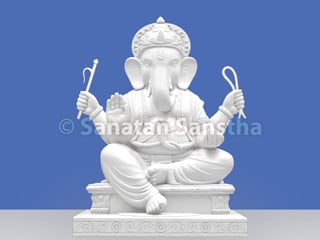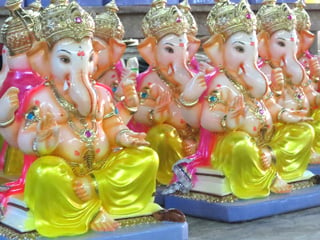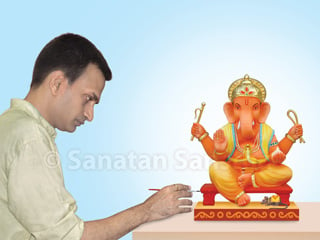
1. Usual Idol
The sculpture of Shri Ganapati is described in the Shri Ganapatyatharvashirsha as Ekadantam, Chaturhastam ….(एकदन्तं चतुर्हस्तं)’, meaning, He who is ekadanta (Has only one tusk), is chaturbhuja (Has four hands), holds a pash (Noose) and an ankush (Goad), holds a (broken) tusk in one hand and holds the other hand in a varadmudra (A posture bestowing blessings), whose flag bears the symbol of a mouse, who has red complexion, large abdomen (Lambodar), whose ears are like sifting pans, who is adorned in red clothes, whose body is smeared with a paste of raktachandan (Red sandalwood) and who is worshipped with red flowers.
2. Shri Ganapati in various other Forms and Names
A. Sometimes Shri Ganapati is in padmasan (Lotus posture), at times in nrutyamudra (Dance posture).
B. There is a Mundakata (beheaded) Shri Ganapati Idol in the Himalayas. The Name itself suggests that this Idol is without a head. It is said that this is the Idol of the son created by Devi Parvati from the grime of Her body, later beheaded by Deity Shiva.
C. Other complexions : Haridraganapati and the Urdhvaganapati have a yellow complexion. The Pingalaganapati is tawny, while Shri Lakshmiganapati is white in complexion.
D. Linga : Just like the Shivling of Deity Shiva, there is one of Shri Ganapati too. It is called Ganapatayalinga. It is shaped like a pomegranate, lemon, white gourd or Black plum.
E. Nude : In the Tantra path of worship, Shri Ganapati Idol is mostly nude. The Shakti of Shri Ganapati too accompanies the Idol.
F. Feminine form : In the Shakta sect, Shri Ganapati is worshipped in the feminine form. Some such examples are given ahead.
1. Ganeshwari : An extremely attractive sculpted Idol of Ganeshwari is found in the Suchindram Temple in Tamil Nadu.
2. Ardha Ganeshwari : It has a highly meaningful form in the Tantra path of spiritual practice.
3. Ganeshani : This female Deity is found in an extremely rare form of tantrik-mantrik (Followers of the Path of Tantra and Mantra) worship.
G. There are several types of Shri Ganapati Idols such as the Soumyaganapati, Balaganapati, Herambaganapati, Lakshmiganapati, Haridraganapati, Uchhishṭaganapati, Suryaganapati, Varadaganapati, Dwibhujaganapati, Dashbhujaganapati, Nartanaganapati, Uttishṭhitaganapati, Ganapati with the trunk curved towards the right etc.
3. Implied meaning of various parts of the Idol
A. Entire Idol
Omkar, Nirgun
B. Trunk
1. Trunk curved towards the right
An Idol of Shri Ganapati with the trunk curved towards the right is called Dakshinamurti or Dakshinabhimukhi murti (Idol facing the south). Dakshina refers to the southern direction or the right side. The southern direction leads to the region of Yama, the Deity of death, while the right side belongs to the Suryanadi (The Sun channel). He who can face the direction of the region of Yama is powerful. So also, one with an activated Suryanadi is also radiant. Thus, in both senses, the Shri Ganapati Idol with the trunk curved towards the right is said to be ‘Jagrut (Awakened)’. Scrutiny of our demerits and merits is carried out in the region of Yama, that is, in southern direction and hence, that direction is repulsed. Scrutiny akin to that done in the southern region after death begins when alive, if we sit facing the south (or sleep with the legs towards the south). The Dakshinabhimukhi Idol is not worshipped ritualistically in the usual manner because tiryak (or Raja component) waves are emitting from the south. The ritualistic worship of such an Idol is performed by strict abidance of all the norms of ritualistic worship scrupulously. Consequently, the sattvikta (Purity) is augmented and the distress from the Raja-Tamawaves coming from the south is prevented.
2. Trunk curved towards the left
An Idol with the trunk curved towards the left is called Vamamukhi Shri Ganapati. Vam means the northern direction or the left side. The Chandranadi (Moon channel) is situated to the left. It bestows tranquility. Besides, the northern direction, conducive for Spirituality, is Anand-bestowing; hence, mostly the Vamamukhi Shri Ganapati is worshipped. It is worshipped ritualistically in the usual manner.
C. Modak
1. ‘Mod (मोद)’ means Anand and ‘ka (क)’ means a small portion. Therefore, modak (मोदक) is a small portion of Anand. A modak is shaped like a coconut, like the cavity ‘kha’ in the Brahmarandhra. When Kundalini (Spiritual energy) reaches the ‘kha’ cavity, it gives the spiritual experience of Anand. Modak held in the hand signifies Anand-bestowing Shakti.
2. Modak symbolises dnyan (Spiritual knowledge); hence, it is also termed dnyanmodak. Initially, it seems that spiritual knowledge is little (represented by the tip of the modak); but as we start studying Spirituality, we realise its vastness (symbolised by the base of the modak). The modak is sweet. The Anand acquired through spiritual knowledge, too, is like that.
3. The shape of a modak is like that of a coconut. A striking feature of a coconut is that it attracts and imbibes distressing vibrations. Likewise, modak, too, attracts and imbibes the difficulties and the distress due to negative energies of its devotees. Shri Ganapati eats modak, meaning He eliminates the difficulties and the negative energies.
D. Ankush (Goad)
It is the destroyer of the energies that are harmful to the mission of acquiring of dnayn and Anand.
E. Pash (Noose)
Shri Ganapati is one who ties the noose around negative entities and takes them away.
F. Serpent around the waist
The Universal Kundalini.
G. Hood of the serpent
Activated Kundalini.
H. Mouse
Mouse implies that the Raja component is under the control of Shri Ganapati.
4. Why should Ganesha Idol be of pipeclay ?
According to Dharmashastra, worshipping the Idol of pipeclay has immense benefits at a spiritual level.
In ‘Dharmasindhu’, the following rule is given about ‘How should be an Idol of Shri Ganesha on Ganesh Chaturthi ?
तत्र मृन्मयादिमूर्तौ प्राणप्रतिष्ठापूर्वकं विनायकं षोडशोपचारैः सम्पूज्य…।- Dharmasindhu, paragraph 2
Meaning : On this day (on Bhadrapad Shukla Paksha 4) the Idol of Shri Ganesha should be made of clay, etc. and is worshipped in Shodashopachar manner after performing its consecration.
According to another reference, in the Scripture called ‘Smrutikaustubha’, there is a reference that Shrikrishna asked Dharmaraja to perform vrat of Siddhivinayak. It gives a detailed description of what an Idol should look like.
स्वशक्त्यागणनाथस्य स्वर्णरौप्यमयाकृतिम्।
अथवामृन्मयी कार्या वित्तशाठ्यंं नकारयेत् ॥ – Smrutikaustubha
Meaning : For this (Siddhivinayaka’s) worship, idols of gold, silver or clay should be made as per one’s own might. There should be no stinginess in this.
Since it clearly states that Idols should be made of gold, silver, or clay, it is inappropriate from the viewpoint of Dharmashastra to make Idols from other material. ‘

 What are the incarnations of Shri Ganesh in each yug ?
What are the incarnations of Shri Ganesh in each yug ? What are the different variations of Ganesh idol?
What are the different variations of Ganesh idol? Why is Ganesh idol made of clay only scientific?
Why is Ganesh idol made of clay only scientific?